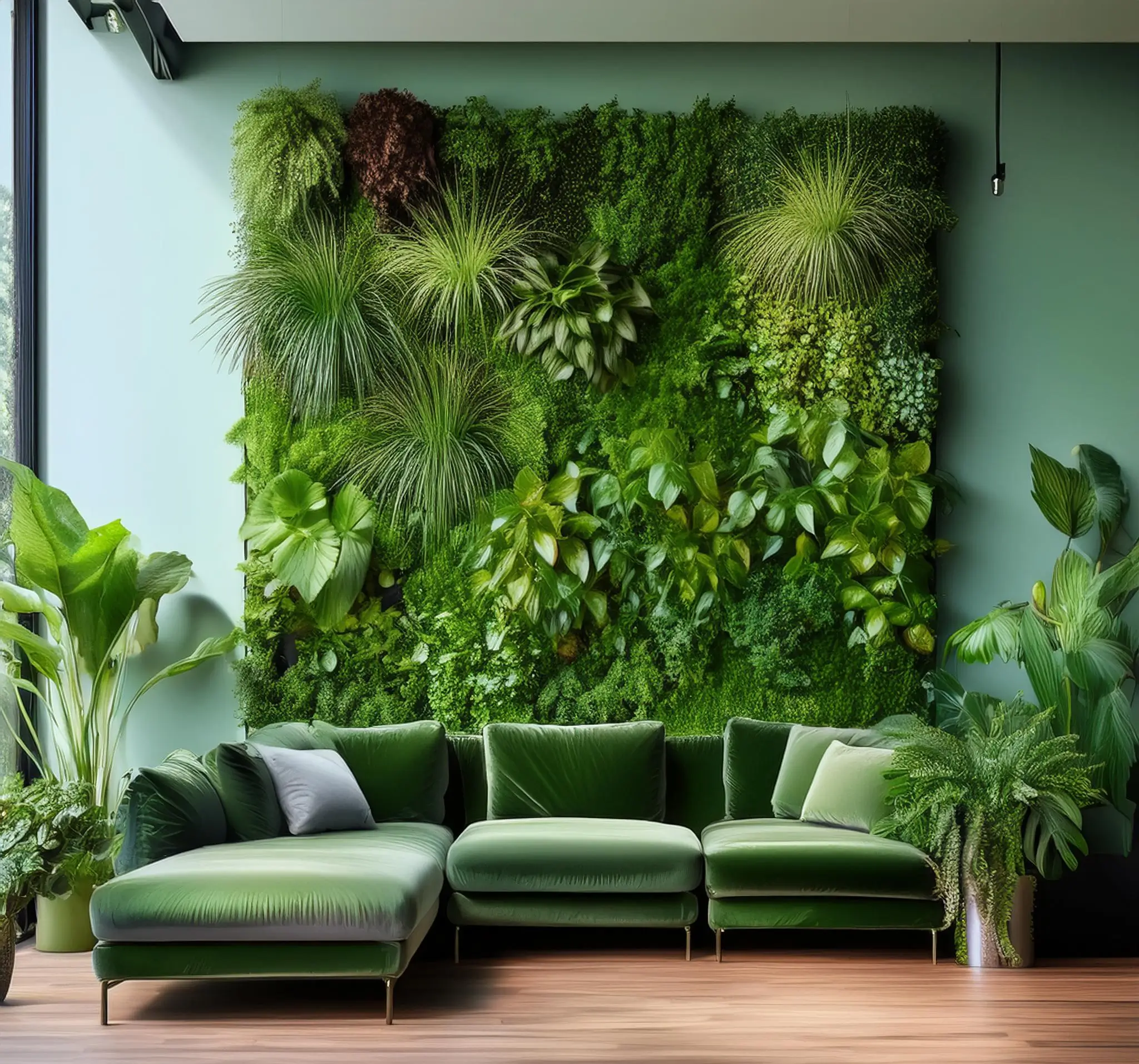
In today’s world of compact living spaces and urban environments, greenery is often sacrificed due to limited space. However, the desire to incorporate nature into our homes and offices remains strong. One of the most innovative solutions to this challenge is the concept of living walls, also known as vertical gardens, particularly designed for indoor spaces.
Living walls bring nature indoors, offering aesthetic appeal while also improving indoor air quality, enhancing mental well-being, and creating a healthier living or working environment. In this comprehensive guide, we’ll explore what living walls are, their benefits, how they work, and how you can create your own living wall for an indoor space.
What Are Living Walls?
A living wall is a vertical structure that holds a variety of plants arranged in a way that allows them to grow upwards. Unlike traditional horizontal gardens, living walls use vertical space, which is ideal for indoor environments with limited floor area. These walls can be freestanding or attached to a wall, and they often feature a framework for mounting plants in individual pots or integrated growing systems.
Living walls come in different designs, from small decorative panels to expansive installations that cover entire walls. They can be used in homes, offices, hotels, restaurants, and even educational institutions to bring a touch of nature to any indoor setting.
The Benefits of Living Walls
Living walls do more than just look stunning; they offer numerous environmental, health, and psychological benefits, making them an excellent addition to indoor spaces.
1. Improved Air Quality
Indoor plants naturally filter the air by absorbing pollutants such as volatile organic compounds (VOCs), carbon dioxide, and other airborne toxins. Installing a living wall can significantly improve the air quality in your home or office. Plants such as ferns, peace lilies, and spider plants are particularly effective at cleaning the air.
2. Temperature Regulation
Living walls can help regulate indoor temperatures by absorbing heat during the day and releasing it at night. This effect helps to keep rooms cooler in the summer and warmer in the winter, potentially reducing energy costs.
3. Noise Reduction
Plants are natural sound absorbers, which makes living walls useful for reducing noise levels in busy or open-plan spaces. The leaves and other plant structures can diffuse sound, making indoor environments quieter and more serene.
4. Boosted Mental Well-being
Research has shown that exposure to indoor plants can positively affect mental health, reducing stress, anxiety, and fatigue. Living walls create a calming and visually appealing environment, boosting mood and enhancing productivity in workplaces and homes.
5. Enhanced Aesthetic Appeal
Living walls are natural art, adding beauty, texture, and color to any indoor space. They can be designed in various shapes and patterns, becoming a unique and eye-catching feature of the room.
How Living Walls Work
Living walls use a combination of framework, plants, soil, and irrigation systems to sustain plant life on a vertical surface. Here’s how the different components typically function together:
1. Framework
The framework of a living wall consists of a sturdy structure that holds the plants in place. This can be made from materials like metal, wood, or plastic. Depending on the size and type of living wall, the framework may support individual plant pots or a continuous substrate layer where plants can grow.
2. Growing Medium
The growing medium is where the plants are rooted. Instead of traditional soil, many indoor living walls use lightweight materials such as coco coir, sphagnum moss, or felt, which hold moisture and provide plant nutrients. Some systems also use hydroponics, where plants grow in a nutrient-rich water solution without any soil.
3. Irrigation System
An irrigation system is essential to hydrate plants, especially in larger living walls. Many indoor systems use drip irrigation or hydroponic systems to deliver water directly to the plant roots. Some living walls also feature self-watering systems that simplify maintenance by automating the watering process.
4. Lighting
Indoor plants require adequate light for photosynthesis, and in some cases, natural light may not be sufficient. Grow lights or other forms of artificial lighting are often used to compensate. These lights are typically installed near the top of the living wall to mimic natural sunlight.
Types of Living Walls
Depending on available space, budget, and personal preferences, living walls can be tailored to fit various indoor environments. Here are some common types of living walls suitable for indoor use:
1. Modular Living Walls
Modular living walls consist of pre-planted panels or trays that can be easily mounted onto walls. Each module contains individual plants, allowing for flexibility in design. These panels can be swapped or replaced as needed, making it easy to refresh the look of your living wall over time.
2. Freestanding Living Walls
Freestanding living walls are standalone structures that can be placed anywhere in the room, similar to a piece of furniture. They are ideal for spaces where wall mounting isn’t possible, and they can also be moved around as needed. Freestanding walls are great for dividing large rooms or creating privacy in open-plan offices.
3. Wall-Mounted Planters
Wall-mounted planters offer a simple and cost-effective way to create a living wall. These planters are typically smaller and less complex than modular or freestanding systems, but they still allow you to grow various plants on your walls. You can install several planters in different arrangements to achieve a vertical garden effect.
4. Hydroponic Living Walls
Hydroponic living walls use a soilless growing system where plants are grown in water enriched with nutrients. These systems are highly efficient and can be easily maintained. Hydroponic walls are popular in commercial spaces due to their low maintenance needs and high growth rates.
How to Create a Living Wall for Indoor Spaces
Creating a living wall for your indoor space may seem daunting, but it can be broken down into manageable steps. Here’s a detailed guide to help you begin:
1. Choose the Right Location
It is crucial to select the right spot for your living wall. Choose a spot that gets sufficient light, either from natural sunlight or grow lights. Ensure that the wall is strong enough to support the weight of the plants and the framework, especially if you’re using a modular system.
2. Select Your Plants
Choosing the right plants is vital for a successful living wall. Opt for low-maintenance, air-purifying plants that thrive in indoor conditions. Some popular choices include:
- Spider plants: Excellent for air purification and easy to grow.
- Ferns: Perfect for adding lush greenery.
- Philodendrons: Adaptable to low-light conditions.
- Succulents: Ideal for minimal water requirements.
- Pothos: Known for their trailing vines and low-maintenance nature.
When selecting your combination, consider each plant’s light and water needs. Group plants with similar requirements together to make care easier.
3. Install the Framework
Once you’ve chosen the location and plants, install the framework for your living wall. If you use a modular system, mount the panels according to the manufacturer’s instructions. For DIY systems, use wall planters or shelves to hold your plants.
4. Set Up the Irrigation System
If your living wall is large or you’re using a hydroponic system, set up an irrigation system to ensure that all plants receive enough water. Small living walls may not require an irrigation system, but you’ll need to water your plants regularly using a spray bottle or watering can.
5. Arrange the Plants
Carefully arrange your plants in the framework or containers, ensuring that they are securely in place. Consider the growth patterns of each plant and arrange taller plants towards the bottom and shorter ones at the top to create balance.
6. Maintain Your Living Wall
Regular maintenance is key to keeping your living wall healthy. Check for signs of overwatering or underwatering, trim dead or yellowing leaves, and monitor the plants for pests. Adjust the lighting and watering as needed based on the plants’ growth.
Living Wall Care and Maintenance
Caring for a living wall involves regular watering, trimming, and checking for pests or diseases. Here are a few tips to keep your indoor vertical garden thriving:
- Water Regularly: Ensure your plants get enough water, especially if your living wall doesn’t have an automated irrigation system. Check the moisture levels regularly and adjust based on the plant type.
- Fertilize: Plants in living walls may need occasional fertilization to stay healthy, especially if they are growing in soilless media.
- Prune: Regularly prune back any overgrown plants to maintain the structure and appearance of your living wall. This also helps promote new growth.
- Monitor Light Levels: Ensure your living wall gets the necessary light, adjusting grow lights or repositioning plants as needed.
Conclusion
Living walls are a fantastic way to bring nature into indoor spaces, offering both practical and aesthetic benefits. Whether you want to improve air quality, enhance your home’s décor, or create a more relaxing environment, a living wall is an innovative and space-saving solution. You can enjoy the beauty and health benefits of a vertical garden inside your home or office by selecting the right plants, setting up a proper irrigation system, and maintaining your walls.
With careful planning and attention to detail, your indoor living wall can thrive and transform your space into a green oasis.

